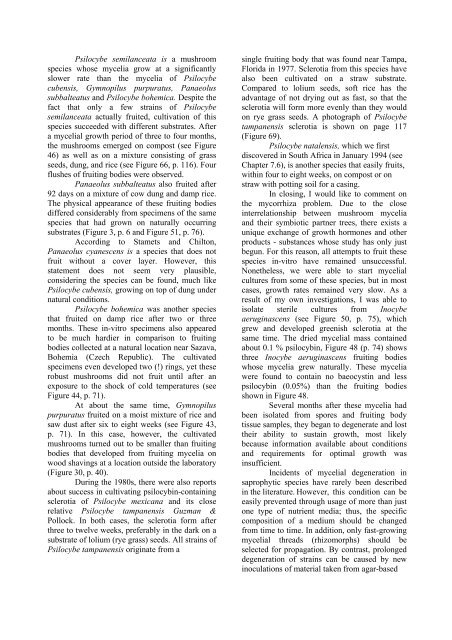Jochen Gartz - Magic Mushrooms Around the ... - preterhuman.net
Jochen Gartz - Magic Mushrooms Around the ... - preterhuman.net
Jochen Gartz - Magic Mushrooms Around the ... - preterhuman.net
Create successful ePaper yourself
Turn your PDF publications into a flip-book with our unique Google optimized e-Paper software.
Psilocybe semilanceata is a mushroom<br />
species whose mycelia grow at a significantly<br />
slower rate than <strong>the</strong> mycelia of Psilocybe<br />
cubensis, Gymnopilus purpuratus, Panaeolus<br />
subbalteatus and Psilocybe bohemica. Despite <strong>the</strong><br />
fact that only a few strains of Psilocybe<br />
semilanceata actually fruited, cultivation of this<br />
species succeeded with different substrates. After<br />
a mycelial growth period of three to four months,<br />
<strong>the</strong> mushrooms emerged on compost (see Figure<br />
46) as well as on a mixture consisting of grass<br />
seeds, dung, and rice (see Figure 66, p. 116). Four<br />
flushes of fruiting bodies were observed.<br />
Panaeolus subbalteatus also fruited after<br />
92 days on a mixture of cow dung and damp rice.<br />
The physical appearance of <strong>the</strong>se fruiting bodies<br />
differed considerably from specimens of <strong>the</strong> same<br />
species that had grown on naturally occurring<br />
substrates (Figure 3, p. 6 and Figure 51, p. 76).<br />
According to Stamets and Chilton,<br />
Panaeolus cyanescens is a species that does not<br />
fruit without a cover layer. However, this<br />
statement does not seem very plausible,<br />
considering <strong>the</strong> species can be found, much like<br />
Psilocybe cubensis, growing on top of dung under<br />
natural conditions.<br />
Psilocybe bohemica was ano<strong>the</strong>r species<br />
that fruited on damp rice after two or three<br />
months. These in-vitro specimens also appeared<br />
to be much hardier in comparison to fruiting<br />
bodies collected at a natural location near Sazava,<br />
Bohemia (Czech Republic). The cultivated<br />
specimens even developed two (!) rings, yet <strong>the</strong>se<br />
robust mushrooms did not fruit until after an<br />
exposure to <strong>the</strong> shock of cold temperatures (see<br />
Figure 44, p. 71).<br />
At about <strong>the</strong> same time, Gymnopilus<br />
purpuratus fruited on a moist mixture of rice and<br />
saw dust after six to eight weeks (see Figure 43,<br />
p. 71). In this case, however, <strong>the</strong> cultivated<br />
mushrooms turned out to be smaller than fruiting<br />
bodies that developed from fruiting mycelia on<br />
wood shavings at a location outside <strong>the</strong> laboratory<br />
(Figure 30, p. 40).<br />
During <strong>the</strong> 1980s, <strong>the</strong>re were also reports<br />
about success in cultivating psilocybin-containing<br />
sclerotia of Psilocybe mexicana and its close<br />
relative Psilocybe tampanensis Guzman &<br />
Pollock. In both cases, <strong>the</strong> sclerotia form after<br />
three to twelve weeks, preferably in <strong>the</strong> dark on a<br />
substrate of lolium (rye grass) seeds. All strains of<br />
Psilocybe tampanensis originate from a<br />
single fruiting body that was found near Tampa,<br />
Florida in 1977. Sclerotia from this species have<br />
also been cultivated on a straw substrate.<br />
Compared to lolium seeds, soft rice has <strong>the</strong><br />
advantage of not drying out as fast, so that <strong>the</strong><br />
sclerotia will form more evenly than <strong>the</strong>y would<br />
on rye grass seeds. A photograph of Psilocybe<br />
tampanensis sclerotia is shown on page 117<br />
(Figure 69).<br />
Psilocybe natalensis, which we first<br />
discovered in South Africa in January 1994 (see<br />
Chapter 7.6), is ano<strong>the</strong>r species that easily fruits,<br />
within four to eight weeks, on compost or on<br />
straw with potting soil for a casing.<br />
In closing, I would like to comment on<br />
<strong>the</strong> mycorrhiza problem. Due to <strong>the</strong> close<br />
interrelationship between mushroom mycelia<br />
and <strong>the</strong>ir symbiotic partner trees, <strong>the</strong>re exists a<br />
unique exchange of growth hormones and o<strong>the</strong>r<br />
products - substances whose study has only just<br />
begun. For this reason, all attempts to fruit <strong>the</strong>se<br />
species in-vitro have remained unsuccessful.<br />
None<strong>the</strong>less, we were able to start mycelial<br />
cultures from some of <strong>the</strong>se species, but in most<br />
cases, growth rates remained very slow. As a<br />
result of my own investigations, I was able to<br />
isolate sterile cultures from Inocybe<br />
aeruginascens (see Figure 50, p. 75), which<br />
grew and developed greenish sclerotia at <strong>the</strong><br />
same time. The dried mycelial mass contained<br />
about 0.1 % psilocybin, Figure 48 (p. 74) shows<br />
three Inocybe aeruginascens fruiting bodies<br />
whose mycelia grew naturally. These mycelia<br />
were found to contain no baeocystin and less<br />
psilocybin (0.05%) than <strong>the</strong> fruiting bodies<br />
shown in Figure 48.<br />
Several months after <strong>the</strong>se mycelia had<br />
been isolated from spores and fruiting body<br />
tissue samples, <strong>the</strong>y began to degenerate and lost<br />
<strong>the</strong>ir ability to sustain growth, most likely<br />
because information available about conditions<br />
and requirements for optimal growth was<br />
insufficient.<br />
Incidents of mycelial degeneration in<br />
saprophytic species have rarely been described<br />
in <strong>the</strong> literature. However, this condition can be<br />
easily prevented through usage of more than just<br />
one type of nutrient media; thus, <strong>the</strong> specific<br />
composition of a medium should be changed<br />
from time to time. In addition, only fast-growing<br />
mycelial threads (rhizomorphs) should be<br />
selected for propagation. By contrast, prolonged<br />
degeneration of strains can be caused by new<br />
inoculations of material taken from agar-based








![The Big Lie 9-11 and Government Complicity in Mass Murder [PDF]](https://img.yumpu.com/50957077/1/190x245/the-big-lie-9-11-and-government-complicity-in-mass-murder-pdf.jpg?quality=85)








